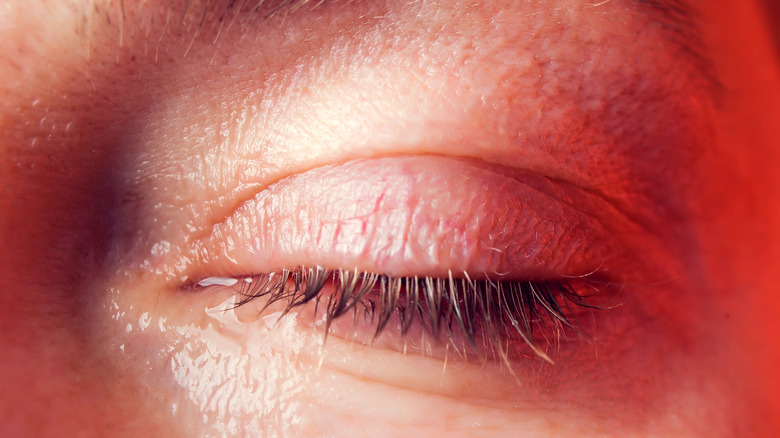How To Treat A Blocked Tear Duct
You might think that tears only make an appearance when we're crying. But the truth is that our tear system is regularly making tears in order to maintain a careful balance of moisture in the eye, according to experts at Mount Sinai. Teetering between lubricated but not overly watery, our tear system helps keep our eyes clean and healthy and is made up of three parts, explains the Cleveland Clinic. The lacrimal glands produce the tears, which then travel out through the puncta — or the tiny holes at the inner corners of your eyes. Attached to the puncta are the nasolacrimal glands, which drain excess tears from the eye down into the nose. In cases of a blocked tear duct, however, the nasolacrimal glands are unable to drain this extra fluid due to an obstruction. As a result, one may experience itchy, uncomfortable, watery eyes.
A blocked tear duct isn't entirely uncommon, particularly in babies, according to WebMD. In fact, most cases of blocked tear ducts in infants resolve on their own within a year following birth. Often this obstruction is caused by a membrane covering that hasn't yet opened up. Pediatricians may suggest a specific massage technique to help break the membrane by softly rubbing the inner corners of the child's eyes alongside the nose for a few seconds in the morning and evening time.
Blocked tear duct treatments for adults
But what about treatment for a blocked tear duct in adults? While some of these methods may also be used on children in some cases, ultimately, treatment will depend on the cause of the obstruction. As per the Cleveland Clinic, a blocked tear duct can be the result of a surrounding tumor, infection, eye injury, as well as the natural aging process as our puncta progressively begin narrowing as we grow older. Depending on the cause, an adult may be treated with medicated eye drops, oral medications, or various procedures.
One such procedure is the process of dilating, probing, and flushing the eye (via Cleveland Clinic). A doctor will expand the hole in the inner corner of the eye and use a probe to flush the tear duct with liquid to clear the obstruction. The process of stenting is similar in approach. With stenting, a doctor will insert a small stent through the opening in the inner eye and down into the tear duct to drain tear build-up. Unlike probing and flushing, however, the stent will remain inserted for a few months.
Surgical options for a blocked tear duct
Usually performed under general anesthesia, a balloon catheter dilation procedure may alternatively be used, in which a physician inserts a small balloon into the tear duct and inflates it to remove the obstruction, reports the Cleveland Clinic. In some cases, a treatment known as a snip punctoplasty may be needed to create a larger hole into your tear duct by making a few small incisions. Lastly, a dacryocystorhinostomy surgical procedure may be warranted if the blocked tear duct has been unresponsive to alternate treatments, in which a surgeon will shape a new passage for tear drainage to filter into the nose.
To help protect against the development of a blocked tear duct, experts at the Cleveland Clinic advise against continuously rubbing one's eyes and sharing any eye makeup products. Additionally, be sure to clean contact lenses thoroughly and engage in regular hand-washing. Experts at Mount Sinai also suggest wearing protective eye gear to safeguard against injury-related tear duct blockages.



